Are you eating clean, working out regularly, and still not seeing the results you deserve? Your metabolism might be the hidden factor holding you back. Many people struggle with sluggish metabolism without realizing how it sabotages their energy, weight, and health goals.
In this comprehensive guide, we’ll explore how to boost your metabolism naturally—no gimmicks, just science-backed strategies and practical tips. Whether you’re trying to lose weight, increase energy, or simply improve your overall wellness, understanding your metabolic function is the first step. By the end, you’ll be equipped with a step-by-step blueprint to ignite your body’s fat-burning furnace using natural methods.
Understanding Metabolism and Why It Matters

What Is Metabolism and How Does It Work?
Metabolism refers to all the chemical processes your body uses to convert food into energy. These processes are essential for maintaining life—from breathing and digesting to circulating blood and repairing cells. Your basal metabolic rate (BMR) is the amount of energy your body burns at rest just to keep these functions going.
There are three main components of metabolism:
- BMR (Basal Metabolic Rate): About 60–75% of daily calorie use.
- Physical Activity: 15–30% of daily energy expenditure.
- Thermic Effect of Food (TEF): 10% of calories burned during digestion.
Understanding this breakdown is key to finding the right ways to naturally boost your metabolism.
Why Metabolism Influences Weight and Energy
A faster metabolism means your body burns more calories at rest and during activity, making it easier to maintain or lose weight. It also impacts how energized or sluggish you feel throughout the day. Factors that slow your metabolism—like aging, poor sleep, or low muscle mass—can lead to fatigue and weight gain even with a healthy lifestyle.
📌 Did You Know?
After age 30, your metabolism can slow by 2–5% per decade unless you actively counteract it with diet and exercise strategies.
Scientific Insight: How Metabolism Affects Fat Storage
Research published in The Journal of Clinical Endocrinology & Metabolism shows that individuals with lower metabolic rates are more prone to store fat, especially visceral fat. On the other hand, people with higher muscle mass tend to have a higher resting metabolic rate (RMR), which aids in better weight management and energy utilization.
Visual Breakdown: Metabolic Pathways Chart
| Metabolic Factor | Role in Energy Use | Modifiable? |
|---|---|---|
| Basal Metabolic Rate | ~70% | Partially |
| Physical Activity | ~20% | Yes |
| Thermic Effect of Food | ~10% | Slightly |
Foods That Naturally Boost Metabolism
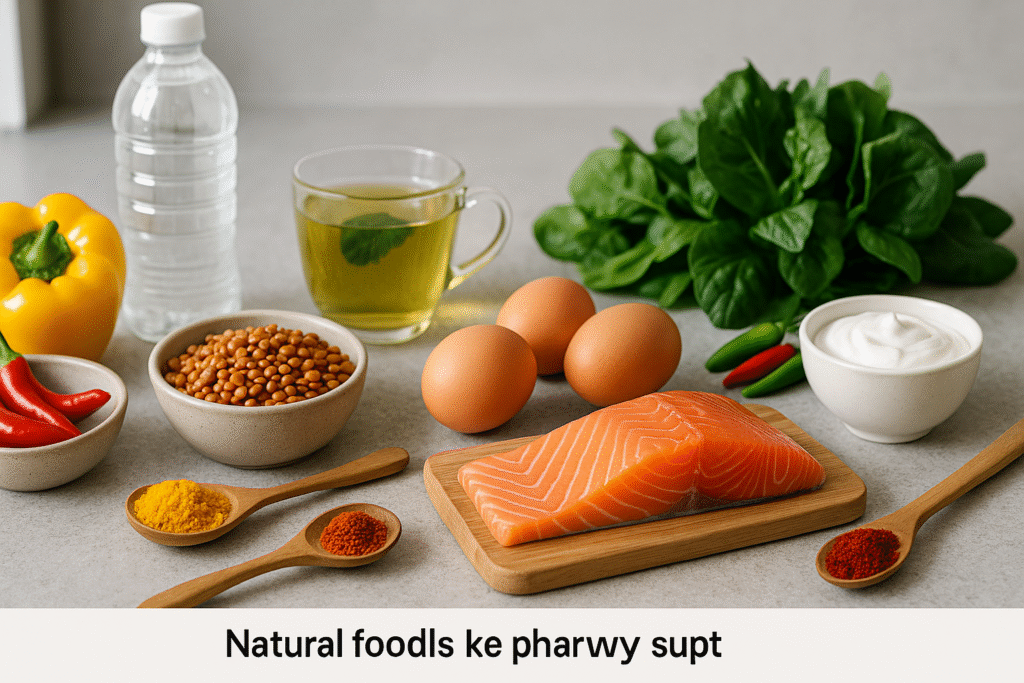
Protein-Rich Foods Increase Thermogenesis
Eating protein doesn’t just help build muscle—it also boosts your metabolism through the thermic effect of food (TEF). TEF refers to the calories your body burns to digest, absorb, and process nutrients. Protein has a significantly higher TEF (20–30%) compared to carbs (5–10%) or fats (0–3%).
Great protein sources that aid metabolism include:
- Lean meats (chicken, turkey, grass-fed beef)
- Fish and seafood
- Eggs
- Legumes (lentils, chickpeas)
- Greek yogurt and cottage cheese
💡 Quick Tip:
Include a source of lean protein in every meal to naturally elevate your metabolic rate and preserve lean muscle mass.
Spicy Foods and Metabolism Activation
Capsaicin, the compound responsible for the heat in chili peppers, has been shown to temporarily boost metabolic rate by increasing thermogenesis. Studies show that spicy foods can increase calorie burning by up to 50 calories per meal.
Add these to your diet for a spicy metabolism kick:
- Cayenne pepper
- Jalapeños
- Chili powder
- Red pepper flakes
Green Tea and Coffee: Natural Stimulants
Green tea contains catechins and a modest dose of caffeine, both of which enhance fat oxidation. Coffee, with its higher caffeine content, can also stimulate the central nervous system, increasing energy expenditure.
A study from The American Journal of Clinical Nutrition found that drinking green tea extract significantly improved fat burning, especially during exercise.
✅ Expert Summary:
Combining caffeine and antioxidants (like EGCG in green tea) can improve metabolic health when consumed moderately.
Hydration and Metabolic Efficiency
Even mild dehydration can slow your metabolism. Drinking cold water may increase calorie burning slightly as your body expends energy to heat it to body temperature.
Aim for:
- At least 2 liters of water per day
- Herbal teas (ginger, peppermint, hibiscus)
- Hydrating fruits and vegetables (cucumber, watermelon, celery)
Lifestyle Habits That Support a Faster Metabolism

Regular Strength Training and Muscle Maintenance
Muscle tissue burns more calories than fat tissue—even at rest. That’s why strength training is one of the most effective ways to boost your basal metabolic rate. The more lean muscle you have, the more energy your body uses throughout the day.
Key strength-building exercises include:
- Weight lifting
- Resistance bands
- Bodyweight exercises (push-ups, squats, planks)
💡 Quick Tip:
Incorporate resistance training at least 3 times per week to support long-term metabolic health.
Prioritizing Quality Sleep
Lack of sleep can slow down your metabolism, disrupt hunger hormones (ghrelin and leptin), and increase cravings. A study in Sleep journal found that even one night of poor sleep can reduce insulin sensitivity and metabolic rate.
Aim for:
- 7–9 hours of uninterrupted sleep
- A consistent bedtime routine
- Reducing screen time before bed
📌 Did You Know?
Sleep-deprived individuals are more likely to gain weight due to lower metabolic efficiency and increased appetite.
Daily Non-Exercise Activity (NEAT)
NEAT refers to the calories burned from everyday movements like walking, cleaning, and standing. Increasing NEAT can significantly impact your metabolism, especially if you have a sedentary lifestyle.
Simple ways to boost NEAT:
- Take the stairs instead of the elevator
- Stand while working (use a standing desk)
- Do light chores or stretch during TV time
Stress Management and Cortisol Balance
Chronic stress increases cortisol levels, which can lead to fat storage and metabolic slowdowns. Practicing stress-reduction techniques helps maintain hormonal balance and support metabolism.
Effective stress-reducing habits:
- Meditation or mindfulness
- Deep breathing exercises
- Nature walks or journaling
✅ Expert Summary:
Balanced hormones are essential for a fast, efficient metabolism—so managing stress is just as important as exercise and diet.
Step-by-Step Plan to Boost Your Metabolism Naturally
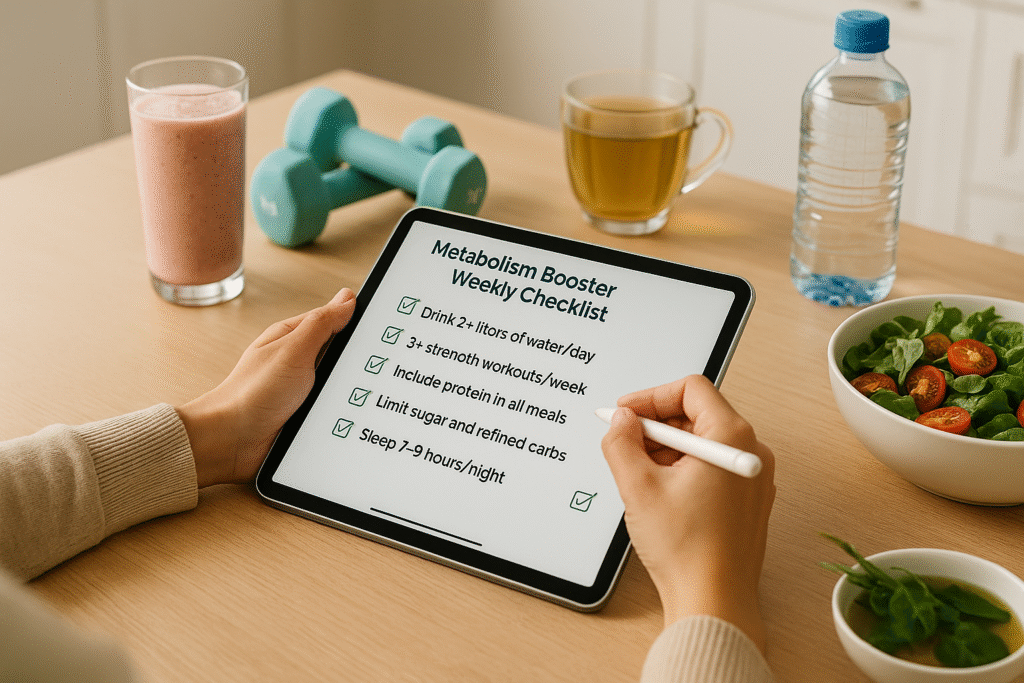
Key Ingredients and Natural Tools
To kick-start your metabolism, focus on integrating key metabolism-friendly ingredients and routines into your daily life. These include:
- Protein sources (chicken, fish, lentils)
- Metabolic spices (ginger, turmeric, cayenne)
- Hydration aids (herbal teas, lemon water)
- Supplements (if needed, like green tea extract or magnesium)
Natural tools to support consistency:
- Meal prep containers
- Fitness tracker or pedometer
- Journal for sleep and stress tracking
💡 Quick Tip:
Stock your kitchen with metabolism-boosting ingredients and prep simple meals in advance to stay on track.
Your Simple Daily Routine for a Metabolic Boost
A practical day might look like this:
- Morning: Hydrate with lemon water + 10 min walk
- Breakfast: Protein smoothie with chia seeds
- Midday: Strength workout or active break + spicy lunch
- Afternoon: Green tea + short stretching session
- Evening: Protein-rich dinner + 10 min wind-down routine
Even small changes can lead to measurable improvements in energy and fat burning over time.
Weekly Checklist to Stay on Track
| Task | Goal | Done? |
|---|---|---|
| Drink 2+ liters of water/day | Daily hydration | ☐ |
| 3+ strength workouts/week | Muscle and metabolism boost | ☐ |
| Include protein in all meals | TEF and muscle preservation | ☐ |
| Limit sugar and refined carbs | Stabilize blood sugar | ☐ |
| Sleep 7–9 hours/night | Hormonal balance | ☐ |
Bonus Expert Tips to Maximize Long-Term Metabolism

Advanced Nutrition Strategies
Beyond the basics, there are advanced techniques that can keep your metabolism sharp for years:
- Cyclic calorie intake: Occasionally increasing calories (known as “refeeds”) can prevent metabolic adaptation during weight loss.
- Intermittent fasting: Helps regulate insulin levels and may promote fat-burning efficiency.
- Anti-inflammatory diet: Reduces chronic inflammation that can interfere with metabolic processes.
Include nutrient-dense superfoods like:
- Berries
- Leafy greens
- Omega-3-rich fish
- Nuts and seeds
✅ Expert Summary:
Cycling your nutrition and reducing inflammation supports metabolic flexibility and long-term fat-burning.
Sustainable Long-Term Implementation
Consistency is more powerful than perfection. Focus on small, repeatable habits that build momentum:
- Prepare meals ahead of time
- Set realistic fitness goals
- Prioritize rest and recovery
- Reflect on progress weekly
📌 Did You Know?
It takes just 21 days to build a habit, but maintaining it for 90+ days makes it part of your identity.
How to Apply This to Your Routine
Daily & Weekly Routines
Daily:
- Morning hydration
- Protein-packed meals
- 20–30 minutes of movement
- Nighttime stress reduction
Weekly:
- Strength training 3x
- Active recovery (yoga, walks)
- Grocery shopping and meal prep
- One tech-free night for deeper rest
Functional Recipes to Try
- Spicy Metabolism Smoothie: Protein powder, cayenne, ginger, spinach, almond milk
- Fat-Burning Stir Fry: Chicken, broccoli, bell peppers, garlic, turmeric, olive oil
- Green Energy Tea: Green tea, mint, lemon slice, cinnamon stick
7-Day Mini Metabolism Challenge
| Day | Focus |
|---|---|
| 1 | Drink 2L water + add lemon |
| 2 | Eat protein at every meal |
| 3 | Walk 30 minutes outdoors |
| 4 | Avoid sugar and alcohol |
| 5 | Do a 20-min strength workout |
| 6 | Practice 10-min deep breathing |
| 7 | Reflect + prep for next week |
Conclusion
Boosting your metabolism naturally isn’t about quick fixes—it’s about creating consistent habits that support your body’s energy systems. By understanding how metabolism works and making smart lifestyle, nutrition, and movement choices, you can enhance your vitality, support fat loss, and feel energized every day.
Small daily efforts can lead to major long-term changes. Stay consistent, stay curious, and let your metabolism work for you.
Primary Keyword included: how to boost your metabolism naturally
Main Takeaways
- Protein and strength training are foundational for metabolism.
- Sleep, hydration, and stress management matter more than most realize.
- Small daily actions have a cumulative effect over time.
- Use a 7-day challenge to build momentum.
- Advanced strategies like intermittent fasting or re-feed days can enhance results.
Further Reading: Take Your Metabolic Health Even Further
If you’re serious about optimizing your metabolism and unlocking sustained energy and fat-burning, these Genius Nutra resources offer powerful next steps:
- 🔬 MitoLyn Review: Mitochondrial Support for Energy & Metabolism
Discover how supporting your mitochondria—the energy engines of your cells—can enhance metabolic performance. - 🌿 Moringa Magic Review: A Natural Superfood for Weight and Wellness
Explore how moringa can work synergistically with your metabolism-boosting plan as a nutrient-dense powerhouse. - 🏋️♀️ The Science Behind HIIT: Burn Fat Faster with Smart Training
Learn why HIIT is one of the most effective workout strategies for revving up your metabolic rate—fast.
💡 Pro Tip:
Combine nutrient-rich supplements with metabolic training techniques to amplify your results naturally and sustainably.



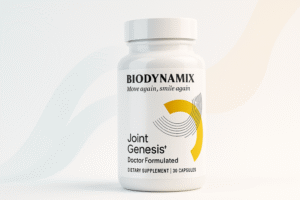







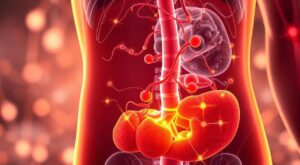
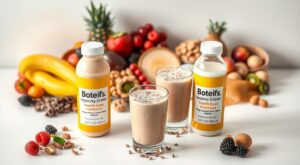
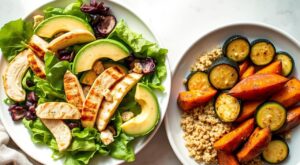

4 Responses